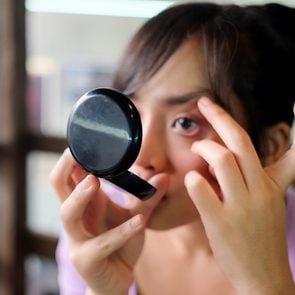
Sources of iron
All life requires iron. Humans use it to make, among other things, hemoglobin and myoglobin, proteins that help store and carry oxygen throughout our bodies.
Our iron supply needs to be continually replenished with food. Good sources of iron include meat, fish, egg yolks, beans, nuts and dark-green vegetables. (Here are more iron-rich foods worth adding to your diet.) You can boost your intake further by cooking in a cast iron pan: you’ll be eating microscopic pieces of your skillet along with your meal, but your body can use them. Iron supplements are another possibility; as their name suggests, they’re intended as an addition to a nutritious diet when necessary, not a substitute for it. (Find out how to clean cast iron pans if you want them to last forever.)
There are two main types of dietary iron: heme (from meat only) and non-heme (found in both animal and plant sources). “Heme iron is well absorbed by the body,” says Agnès de Sesmaisons-Lecarré, a member of the European Food Safety Authority’s nutrition unit. “By contrast, the absorption of non-heme iron is strongly influenced by interactions with other meal components.” For instance, the muscle tissue in meats or foods rich in vitamin C, such as oranges and tomatoes, can increase its absorption.
Read up on the 13 essential vitamins your body needs to stay healthy.

Iron deficiency symptoms
The body keeps some iron in reserve. However, sustained low intake or low absorption can lead to anemia, which is a lack of healthy red blood cells for carrying oxygen. Possible iron deficiency symptoms include fatigue, shortness of breath, a feeling of being cold, headache, irritability, dizziness, or a paling of the skin. It’s important to address iron deficiency anemia (diagnosed through blood tests) because it can lead to heart problems in the long run.
Iron deficiency anemia can also be a sign of an underlying condition such as celiac disease, inflammatory bowel disease, or colorectal cancer. Because iron is shed with blood leaving the body, other people with a heightened risk include menstruating women and frequent blood donors.
Can you get too much iron?
Short of swallowing far more than the recommended dose of supplements, getting too much iron is unlikely—unless you have hemochromatosis, a genetic disorder that affects up to one in 200 people of Northern European descent. It promotes excessive iron absorption, causing signs such as joint pain, belly pain and fatigue. Left untreated, hemochromatosis may ultimately trigger serious heart or liver trouble, but when managed with a low-iron diet or regular blood removal, it need not become a problem.
Now that you know the iron deficiency symptoms to watch for, find out the healthiest fish you can eat.
The first time Kim Ryberg fainted, she was 13 years old. It was the early 2000s and she was in front of her classroom in rural Montana, delivering a presentation to her peers. She suddenly felt light-headed, then collapsed. When she woke up several minutes later, she went to the school nurse, who wasn’t sure why it had happened. Perhaps it was just nerves, she said. Ryberg went home for the day and hoped it wouldn’t happen again.
She wasn’t so lucky. Throughout high school, Ryberg fainted once or twice a month—in class, during choir recitals, at the grocery store. “It was like Russian roulette,” she says. Every morning she would wonder, “Am I going to faint today?”
Worse, Ryberg started experiencing other alarming symptoms: a racing heartbeat, vomiting and bouts of brain fog that made it hard to concentrate. One moment, she’d be sweating profusely; the next, she was freezing cold.
At first, Ryberg’s parents wondered whether she was just being dramatic, but when the issues continued, they took her to their family doctor. The GP was stumped—she’d never seen anything like it. Ryberg’s parents consulted more physicians, who diagnosed her as stressed or suffering from anxiety. Some said she was faking it to get attention. “Look at me and you’d think I was the healthiest person on planet earth,” she says. “That was part of the problem. I didn’t look sick.”
Living With an Unnamed Illness
Nonetheless, Ryberg’s mysterious illness shaped her life. She frequently missed school because of health problems and medical appointments. She chose not to drive—what if she fainted behind the wheel? “As if high school isn’t hard enough for the average person, I had all of this going on,” she says.
In her 20s, Ryberg moved to Los Angeles to pursue a career as a singer-songwriter. There she met her future husband, Or, a level-headed partner who lovingly helped Ryberg manage her symptoms. Meanwhile, she saw more than a hundred doctors, nurses, naturopaths and other medical professionals in her search for an answer. While some specialists tried to treat particular symptoms, no one could explain them all.
In her late 20s, Ryberg was no longer eligible for affordable health insurance in the U.S. For four years, she stopped seeing doctors entirely and began exercising regularly, hoping to improve her health on her own. Instead, her condition worsened. Simply sitting up could make her light-headed, and she vomited every week or two. Starting in October 2017, she was bedridden for roughly 18 months, relying on her husband and parents to feed, clothe and wash her.
As her condition deteriorated, Ryberg’s friends and family urged her to seek medical help again. But instead of going to a doctor, she went to Google. She’d searched her combination of ailments before but had never found any breakthroughs. This time, however, her online sleuthing led her to Facebook groups where people reported experiencing symptoms similar to hers. If it was indeed what she had, there was a name for it: postural orthostatic tachycardia syndrome, or POTS.
POTS Symptoms
POTS is a blood-circulation disorder. Those who have it experience irregular blood pressure and an abnormal heart rate, which means their blood doesn’t circulate properly, particularly when they make sudden movements or stay sedentary for prolonged periods. As a result, they sometimes faint when they try to stand up. Ryberg happened to fit the most common profile of a POTS patient: a white woman between 13 and 50. “Once I read about it, I started to cry,” she says. She felt she’d finally figured it out.
Ryberg’s research also revealed a specialist who could help her: Dr. Peng-Sheng Chen, a cardiologist at nearby Cedars-Sinai Medical Center in Los Angeles. Ryberg was able to book an appointment with him in October 2020. From the moment she arrived, Chen reassured Ryberg that her illness was real. “Just to have that validation was incredible,” she says.
For Chen, Ryberg’s situation was all too familiar. Though as many as 700,000 Americans have POTS, it is not well known among physicians. As one of the few doctors who focuses on the condition, Chen frequently sees people who have gone years without a correct diagnosis. Like Ryberg, many of them suffered from several broad symptoms that no one specialist was equipped to diagnose or treat.
Causes of POTS
While its ultimate cause is unknown, POTS may occur in patients after they suffer other illnesses, injuries or infections. Chen helped Ryberg discover that hers was linked to a genetic illness called mast cell activation syndrome, or MCAS, which is common among POTS patients. Everyone has mast cells; they produce a chemical called histamine, which helps our bodies fight allergens and, in the process, causes reactions like a runny nose and itchy eyes. But people with MCAS produce more histamine than normal, which creates problems all over the body.
Chen says it’s possible to detect these genetic abnormalities when patients are young, provided a doctor knows to look for them. In some cases, however, people go decades without answers, continuing to experience symptoms and risking anaphylactic shocks that can be fatal.
POTS Treament
Though neither POTS nor MCAS is curable, both are relatively easy to manage. Chen prescribed Ryberg an anti-inflammatory enzyme for her digestive issues, as well as an antihistamine. He also recommended that Ryberg wear compression clothing to keep blood flowing to her head, exercise lying down, and stay hydrated with electrolytes and salt pills.
When Ryberg began observing that regimen, her symptoms got better almost instantly. She still has occasional flare-ups, but her health has dramatically improved; she hardly ever faints anymore. She’s now back on her feet and dreams of starting a family—something that seemed impossible before she started following Chen’s medical advice. “Managing this type of condition comes down to your own willpower and wanting to get better,” she says. “Now that I know what healthy feels like, I will do literally anything to stay that way.”
Next, read the incredible story of how one woman’s x-ray revealed the source of her lifetime of stomach pain.
When it comes to getting your skin squeaky clean, you can rest easy. The style of soap you use is a matter of personal preference. From a sanitary perspective, as long as it contain cleansing ingredients, it doesn’t matter what form it’s in.
“Whether soap comes in a bar or in a liquid form, they are both equally effective at reducing pathogens and removing dirt,” says Rachel Burns, MD, a dermatologist in Edina, Minnesota.
Which soap is better for skin health?
This is where it can get tricky, as it really depends on what you’re looking for. We asked our experts to break down different categories of skin care and decide which type of soap is best for that particular need.
Use liquid soap for hydration
If you’re looking to keep your hands from getting dry and cracked, you may have better luck with a liquid formulation. “Bars of soap often have a high pH, which can cause your skin to dehydrate and dry out more easily,” says Dr. Burns.
However, many bar soaps these days are infused with oils and substances that moisturize the skin, says Ryan Smith, an organic chemist and entomologist in Beaverton, Oregon. (Here’s expert advice on how to avoid dry skin in winter.)
Use bar soap if you want cleaner ingredients
It’s important to be mindful of the ingredients in your soap because many chemicals can cross through your skin and into your bloodstream, says Dr. Burns. The more you wash your hands, the higher the potential for the accumulation of toxic ingredients.
Most bar soaps contain fewer and more natural ingredients than liquid or foaming soaps. But it’s not impossible to find liquid soaps with similarly clean formulations.
Ingredients to look for include glycerine (a cleanser that seals moisture in the skin) and essential oils (lemon, lavender, rose and cedarwood oil). Some soaps will also add coconut oil, sweet almond oil, shea butter, or coconut butter to further soften the skin.
Beware of ingredients like triclosan and parabens (preservatives that extend the shelf life of cosmetics). People with allergies should also read the labels to scan for words like “fragrance” or “parfum,” which can trigger allergies. (Find out the most toxic ingredients in your beauty regimen.)
Use bar soap if you have allergies
People with allergies or sensitive skin do better with soaps that contain fewer ingredients—and the ones they do have are more natural. They should also avoid fragrances and colours. That’s usually easier to find in bar soap formulations. “Bar soaps contain fewer chemicals which means less of a chance for a reaction on your skin,” Smith says.
Use liquid soap if you’re sharing
If you share a bathroom with others, the packaging of liquid soap makes it a friendlier option. “Bars of soap have a higher probability of accumulating bacteria and contamination when compared with liquid soap, especially if you live with other people,” says Dr. Burns. “If someone in the household is sick, you can easily pick up their germs if you have both shared the same soap bar.” Just be sure to clean and sterilize the outside of the bottle regularly. It’s one of the little things people forget to clean but should.
It’s still not 100 percent clear whether those germs that may be found on bar soap transfer to your skin when you wash, though an early study found that bacteria-covered bars of soap did not transfer bacteria during washing.
The bottom line
When it comes to bar soap vs. liquid soap, our experts suggest picking one that will make you the most likely to use it regularly and thoroughly. The best soap also depends on your specific cleaning needs, such as whether you need more hydration or if you’re looking for something that’s environmentally-friendly.
Next, check out 15 green personal care products worth trying.
Every single day, human eyes process thousands of colours. But the way you see the green of the leaves on trees might be slightly different than how someone else sees it. If you think your eyes are sharper than others and want to test your sight skills, challenge yourself to this very difficult colour test. (If you already know that you have 20/20 vision, see if you can pass our tricky medical trivia quiz.)
United Kingdom-based retailer Lenstore created an interactive colour test to see how well various people can perceive colour. It’s not as easy as you might think; fewer than one per cent of people scored perfect. They tested the eyes of 2,000 United Kingdom residents to see which demographics have the strongest colour perception. The 10-question quiz tests people’s ability to differentiate between multiple colour shades.
After the results came in, they found that the majority of people (24.1 per cent) scored six out of 10 on the colour test. Just 23.4 per cent got five right, 17.4 per cent got seven right, and only 0.2 per cent got all 10 questions correct. Here’s the full breakdown:
- 0 right answers: 0.2% of respondents got this result
- 1 right answer: 0.3%
- 2 right answers: 2.2%
- 3 right answers: 7.4%
- 4 right answers: 13.7%
- 5 right answers: 23.4%
- 6 right answers: 24.1%
- 7 right answers: 17.4%
- 8 right answers: 9.1%
- 9 right answers: 2.0%
- 10 right answers: 0.2%
Here’s the colour test itself:
Colour is in the Eye of the Beholder by Lenstore UK
While analyzing the results, Lenstore also discovered that women are able to perceive and differentiate colours better than men. The average score on the test for females was 57.7 per cent and the average for males was 53.8 per cent.
How did you make out on the colour test? If you need another crack at it, test your eyesight with another brainteasing colour quiz.
When your goals are *just* out of reach.
When your favourite jam comes on in the car.
When you didn’t think it through fully.
When the drama is going down.
When you’re reminded why you should never read the comments.
When binge-watching that true crime podcast leaves you a bit on edge.
When you told the boss you’d have that report filed an hour ago.
When you need to speak to the manager.
Scheduling a coffee date that works for everyone.
Putting on your favourite jeans after spending the winter in sweatpants.
When you could really use a hug.
When you’re filing your taxes…
…But you get an unexpected return.
When the Netflix algorithm finally nails your recommendations.
When you are simply not having it.
#TGICaturday
Sometimes you need to take it outside.
Oh no you didn’t.
When you feel a Facebook fight coming on.
When you’re not getting enough attention.
When all you need is that *one* perfect accessory.
When it’s time to do the dishes.
Your first salon appointment in forever.
When you’re done with waiting.
Check out the best YouTube cat videos of all time.
When you just. Don’t. Care.
Enjoyed these funny cat GIFs? This collection of funny good morning GIFs will start your day with a smile!
Tires and wheels are like fashion accessories on a vehicle. In fact, according to the Online Etymology Dictionary, “tire” is a shortened form of “attire,” as in the dressing of a wheel.
As times, trends and tastes change, so has the look of tires and wheels. Tires in the 19th century were solid rubber; now they’re air-filled radials. One hundred years ago, tires were all white. Today, most tires you see on the road are all black.
Curious why tires are black? Here’s what you need to know.
Are Tires Naturally Black?
No.
Natural rubber, one of the main ingredients in tires, is a white, milky latex. The first mass-produced inflatable auto, bicycle and motorcycle tires produced were white, but failed to last.
Today, up to 200 ingredients go into manufacturing the modern tire. Refined carbon black, a byproduct of incomplete combustion of coal and oil, is a key one.
Why Are Tires Black?
Tire manufacturers discovered that adding carbon black, polyester, metal and other synthetic rubber compounds to natural latex helps tires perform better and last longer. Without carbon black, tires wouldn’t last 8,000 kilometres, according to Jack L. Koenig in his book, Spectroscopy of Polymers. It also makes tires black.
Besides significantly increasing tire mileage and durability, carbon black:
- Protects tires from dry rot.
- Improves handling, stability, braking and fuel economy.
- Rapidly transfers heat away from a tire’s core and treads, increasing lifespan.
- Disburses static electricity. In today’s vehicles crammed with highly sensitive electronics, static electricity can quickly damage expensive electronic devices.
- Makes tires easier to keep clean and shiny.
Why Aren’t Tires Available in Colours Besides Black?
They used to be. But people wouldn’t buy them.
Orange, blue, yellow and green tires functioned the same as their black counterparts and passed all North American standards for road safety and performance. But they never became popular.
BFGoodrich once sold tires with colourful treads. According to Michelin, BFGoodrich’s parent company, in the 1950s Goodyear manufactured different colour tires to match your car. That way, drivers could change tires to match their fancy evening attire.
Goodyear also made tires from a translucent material with lights inside! But none were a hit. Just like white tires, colourful tires got dirty fast. They were also expensive. Without carbon black, people weren’t eager to spend extra money on something that wouldn’t last long.
Today, white tires for antique vehicles are readily available. So are wide whitewall tires, made from the original molds to ensure authenticity when restoring classic and collector vehicles.
Tires with raised white letters, narrow whitewalls and thin red-striped sidewalls can be found for custom applications. Pirelli produces tires for ultra-high-end vehicles with different coloured sidewalls, lettering and stripes, using similar compounds and production processes as their F1 racing car tires.
Next, find out what happens if you don’t switch out your winter tires in the spring.

Where I grew up in rural Nova Scotia, we had a country store next door to our farm. When I was very young, it was operated by my grandfather, John W. MacKinnon, then later by my cousin Otis MacKinnon, who was about 25 years older than I was. The following are some of my childhood memories of that old country store in the 1930s.
I barely remember my grandfather operating the store, as I was so young. I do know that most everything was sold on credit and he had a bill pad for each customer. He used a lead pencil and each time he wrote, he would wet the lead by putting the tip up to his mouth.
Most of my recollections are of when my cousin Otis took over running the store in 1936, when I was seven. He, too, used the bill pads to record customers’ purchases. I remember my dad would settle his bill each month, then go home and add up all the items to double-check the amount.
One of the things I remember best about when Otis ran the store was that he sold gas. Back then, gas was pumped into a large glass cylinder atop the gas pump, which marked off the gallons. Otis had a yardstick with paste on the end, which he’d use to check whether there was any water in the underground storage tank, as the tank leaked. If water was present, the paste would turn a different colour. Then, Otis would put a pipe down into the tank with a pitcher pump in order to pump out the water. When he got near the last of the water, he’d strain it through a felt hat—the gas ran through but the water did not.
Don’t miss these fond reminiscences of the country store in Royal Lake, Saskatchewan.

Sticky situations
Sometimes I would be sent to the store for a pail of molasses. This little pail held something around a quart. Otis bought his molasses in 90-gallon barrels and it was so thick that he would set my pail under the spigot, then turn it on and go do something else for five or ten minutes while the pail filled. You could literally spread this molasses on your bread about an eighth of an inch thick.
Most everything in the store was sold in bulk. If you bought a pound of cheese or meat, it would be wrapped in brown paper from a dispenser on the counter and tied with a string around it. Other items such as oatmeal would be measured out into brown paper bags. These, too, would be tied with a string. Flour was usually sold in 90- or 100-pound bags.
Otis put a slot machine in that took nickels (or slugs you could buy for a nickel), so I guess you could say I gambled at a very young age. I remember the day the RCMP came and took the slot machine away. No one was fined as far as I know.
Cold as ice
Most country stores had no refrigeration but Otis had an ice house. It was located across the highway from the store. This was a pole-barn type of building with a roof, boarded up on the outside. When ice was being cut on Mattatall Lake, he would have this large building filled with ice. About three feet of sawdust would be placed around and over the ice. This would last about a year.
He built a room at the rear of the store, with thick walls and a door, which he filled with sawdust. In here he used blocks of ice to keep meat, eggs, milk and other items that needed cool storage. There was a pop cooler in the store, too, where Otis would place a block of ice to have cold pop on hand to sell to his customers.
Local hub
Interesting things always seemed to happen in and around the store. I remember being in there one day when a caravan of cars stopped and a group of people came into the store. Some of them distracted Otis, while others went behind the counter. I don’t know what they managed to take, but Otis soon had them hustled out the door!
Some of the social life of the community centred around the store as well. Especially on Saturday evenings when some of the local farmers and fishermen would come to sit around on chairs or benches and tell stories. I don’t remember the specific stories, but I can still see the fishermen making nets or heads for their lobster traps.
In those days, there were no TVs, computers or cellphones to distract us. Life was busy and full of fun and we lived it to the fullest. The country store played a big part in our lives then.
Next, read the heartwarming story of how Andy’s Chinese food became the best in east central Alberta.
Although the origins of April Fool’s Day are murky, we do know that in France as far back as the 15th century, people would mark the occasion by taping a paper fish onto each other’s backs. By the 18th century, those paper fish had escalated to “kick me” signs and fake tails. With social media now at our fingertips, practical jokes have evolved further still. Pulling the very best from TikTok, Instagram and Pinterest, here are 10 easy April Fool’s pranks for family members to play on each other.
Get ready to laugh out loud with this list of hilarious practical jokes!
@lucasteevens backwards hoodie prank on my mom… #fyp #foryoupage #xycba #prank #reupload ♬ original sound – lucas stevens
Reverse hoodie
If you delight in giving people goosebumps, the “reverse hoodie” prank is worth adding to your April Fool’s Day arsenal. Put on a hoodie backwards, stand with your (real) back towards the fridge. Any passerby will instantly assume you’re searching for something to snack on, while you’re actually waiting for the perfect moment to strike…
View this post on Instagram
Bubble wrap rug
If you shop online at all, bubble wrap isn’t hard to come by. The popular insulation material makes the ultimate fidget toy, but there’s an even more satisfying way to put it to work on April Fool’s Day. Prank your family members by slipping a sheet of bubble wrap under a rug, then lie in wait for the explosion of pops that’s guaranteed to set their heart racing.
View this post on Instagram
Time for a haircut
Ready for chaos? That’s what you’ll get with this easy April Fool’s prank, which starts by downloading a free app called (you guessed it), “Razor Prank.” Once installed, the app activates your phone’s vibration buzz on contact, essentially mimicking the sound and feel of a pro barber’s clippers. All that’s left for you to do is approach a family member from behind, and trick them into thinking they’re getting a very close shave.
View this post on Instagram
Crayon caricature
This April Fool’s prank takes inspiration from a woman who was so bored, she decided to get artistic and slowly but surely replace all the framed family photos around the house with crayon-drawn copies. The funniest part? It took 11 days for her family to notice. See if you can beat that record with your own family. Not much of an artist? No problem! Instead of drawings, you can swap out family portraits with photos of famous celebrities.
Spoiled milk
Caution—this prank could result in a loss of appetite. Take some food colouring (preferably green) and squeeze a few drops directly into the milk carton. Even if you don’t see your family member’s reaction when they pour it into their morning cereal, you’ll certainly hear it. This simple trick is bound to have the biggest impact at breakfast, when your family members are still a bit groggy. The perfect wake-up call on April 1st!
@topperguildGot my payback on my girlfriend 😂 @colie.1♬ Monkeys Spinning Monkeys – Kevin MacLeod
Hoax drink
Grab a mug, a can of whipped cream, and some rainbow sprinkles… Not for a hot cocoa break, but for a mind-bending April Fool’s prank that’s sure to lift your spirits. To prepare this prank, fill a mug with water (unless you actually *want* a sticky mess to clean up), then place a cutting board on top. Carefully invert cutting board and mug, holding the lip of the mug tight to the cutting board to reduce spillage. Cover the base of the mug (now at the top) with a heaping of whipped cream camouflage, and decorate with sprinkles. When you offer this tasty-looking treat to your unsuspecting victim, they’ll grab the handle with the intention of a sip—but will get a sloppy spill instead. There might be some yelling in the aftermath, but this certainly is one of those pranks that you’ll both end up laughing about. Some day.
View this post on Instagram
You’ve got mail
This easy April Fool’s prank will have your family thinking Halloween has come early. Take a fake creepy-crawly—anything will work, whether it’s a snarling reptile or spooky spider—and plant it in your mailbox. The next family member who goes to check the mail will get an even bigger scare than their hydro bill.
View this post on Instagram
Keep an eye on your food!
For this prank, you’ll need to bring out your arts and crafts side. Glue a pair of googly eyes onto every item in your fridge—eggs, condiments, produce, you name it. This is sure to give someone an unexpected jump scare, or at the very least, make them think twice before succumbing to a snack attack. (Psst—this easy prank can also be applied to a book cover!)
@topperguildCracking back PRANK on my stepmom (WATCH TIL THE END) 😂😳 #prank♬ original sound – topperguild
Call the chiropractor
This popular back-cracking prank from TikTok is easy to pull off for April Fool’s Day. All you have to do is request a family member—who’s also in on the prank—to crack your back. When your intended victim is within earshot, bite down on something loud and crunchy—dry pasta might do the trick—and watch chaos ensue. The hardest part will be keeping a straight face.
View this post on Instagram
Oreo with a hint of mint
Here’s a classic example of the old “ingredient swap” prank. Take a handful of sandwich-style cookies (Oreos work nicely), delicately prise them apart and replace that delicious white filling with a generous squirt of toothpaste. The best part? Arranging the modified cookies neatly on a plate, and waiting to see which one of your family members falls to temptation first.
Looking for more easy April Fool’s pranks for your family? Take inspiration from our roundup of the best April Fool’s Day pranks in history.
I recently attended a wedding in rural Quebec, and guests were provided with a car and driver for the 90-minute journey into the hills. That was exciting: A private car! I could pretend I was rich! Since I’m not, though, I had no idea how much this trip actually cost. As a result, when our driver picked us back up at midnight, I secretly fretted all the way home about tipping him.
I fished around nervously in my purse and realized that all I had was a $100 note, which I was keeping for an emergency. I had nothing smaller.
Ack! I couldn’t not tip him, and I had nothing else to offer but two chocolates from the wedding. So, I could tip high—or spectacularly low. I defaulted to high and surrendered the money as my two kids and I clambered out. I was, I confess, too tipsy to think through the idea of asking for change.
In my defence, I wouldn’t have known the math, anyway. The whole matter of tipping has long been a source of awkward interactions—and, for some travellers, mild anxiety—throughout the world. Tipping etiquette varies wildly from country to country. A friend in Rome tells me that Italians get offended by excessive gratuities. “Leaving a big tip is considered vulgar,” she insists. “I’ve had Italian friends make me take money back.”
Uh-oh. Our driver had said he was half-Greek and half-Lebanese. If for some reason the Italian attitude applied to Greeks or Lebanese, my big tip might have left him offended and me missing my emergency cash.
When people take with them their own expectations about tipping etiquette as they roam the world, it generates no small amount of confusion. Norwegians, who come from a culture where wages are high and tips are low, could burn through Las Vegas leaving a trail of outrage with their tiny offerings.
Meanwhile, notoriously high-tipping Americans might insult everyone in Tokyo because good service in Japan is a matter of honour, as in: “How dare you suggest I be rewarded for handing you a plate of sashimi without dropping it in your lap?”
We’re all in an embarrassed mess because there’s no consistent logic to any of this. None!
Tipping began, as far as we know, in Tudor England, with aristocrats swanning about one another’s country homes, paying the servants extra for helping them put on their ruffs. Hundreds of years later, tipping etiquette has become totally arbitrary. A 2016 study from Cornell University, published in the Journal of Economic Psychology, found that people are twice as likely to tip a grocery delivery person than a grocery store clerk, and roughly twice as likely to tip a waiter than a fast-food restaurant worker.
Why is that? A paid job is a paid job, right? The grocery deliverer is paid to deliver and the grocery clerk is paid to clerk. So tipping one and not the other only makes sense in terms of what has become customary.
More examples from the study: Party clowns get tipped more often than dental hygienists—even though the latter bravely confront the malodorous insides of our mouths. Limousine drivers get rewarded more often than fishing guides. And nobody can work out the reasons for these differences; don’t fishing guides go the extra mile, too?
All this is compounded by a phenomenon called “tip creep,” which coincides with the proliferation of portable pay machines that feature automatic tip prompts. They have moved beyond restaurant settings to places like car-repair shops, causing people to feel guilty if they hit the “no tip” option. I recently went to a card-only bakery and their debit machine had tip prompts—for selling me a donut. I tipped 15 percent.
Good luck with any consistency if you’re tipping in Europe. Research across seven European countries in 2020 found that Germans and Swedes are more likely to tip in restaurants than the Spanish or Swiss, while only 40 percent of French consumers offer a gratuity. Norwegians are the least likely to tip: fewer than 15 percent leave a little extra on the table. As for the size of the tip, it’s lowest in France and Norway (less than two percent of the bill), and highest in Germany (7.5 percent) and Sweden (nine percent).
“From a service worker’s viewpoint,” lead study author Stefan Gössling of Sweden’s Lund University notes, “the most desirable tipping culture is probably in Germany, where minimum wages are high, tipping is a norm and tip percentages are high and mostly paid in cash.” In Spain, by contrast, “the situation for service workers is the least favourable; the minimum wage is low, as are tip percentages.”
Compare that to the United States, where restaurant tips of up to 25 percent are now expected for very good service; in Canada, it’s 15 to 20 percent. Why? Because the restaurants pass along wage standards to consumers. It’s the diners’ job to make sure servers can pay their rent.
No one expects a tip in much of Southeast Asia (for example, Thailand or Vietnam) or Australia, beyond saying “keep the change.” In Taiwan and Hong Kong, a 10 percent gratuity is added at most restaurants. Sometimes, that too can feel nerve-wracking. “Even when the server tells you about it up front, it’s awkward,” one friend who encountered this custom said. “Do you tip more if they were really good? What if they weren’t good?”
It’s enough to make your head hurt, and that’s just fretting about cash—will we soon have to worry about tipping with bitcoin? I don’t even understand the notion of cryptocurrency, much less how to use the new tipping apps that are popping up around it.
Maybe that’s how people used to feel about money itself, back when they traded goods and services with shells and weapons and sacks of rice. Back when there was no tipping.
Still sweating over tipping etiquette? Don’t worry—everyone’s entitled to their share of travel mistakes.
Walking along the road near our cottage in Gravenhurst, my grandmother used to stop and point out the trilliums growing in the wilderness on the edge of her property. “You can’t pick those,” she’d caution me, noting that she’d carefully transplanted dozens of the small white flowers over the years. “It’s actually illegal to pick trilliums in Ontario.”
My grandmother was a brilliant woman and a skilled gardener, so I never really questioned this statement. Picking trilliums is illegal, I repeated to others, wondering all the while if there was a secret provincial police squad that handled botanical offenses. (There is not.)
Unfortunately, even the most wonderful grandmothers are wrong sometimes. As it turns out, it’s not always illegal to pick trilliums, though they are incredibly delicate and plucking their blooms could get you into trouble under specific circumstances. Here’s what you need to know before you grab your garden shears.

What’s so special about trilliums?
The trillium grandiflorum, colloquially known as the white trillium or great white trillium, is a small, three-petalled perennial flower that’s found in many parts of Ontario as well as in Nova Scotia. It typically blooms in late April and May before disappearing for the remainder of the year (the plant withers after several weeks but the roots and bulbs remain alive underground). There are several other varieties of trillium found across North America and Asia.
Trilliums are lovely, and there’s a good reason Ontario residents are protective of them. The white trillium has been Ontario’s official floral emblem since 1937, which is why it appears on the provincial government’s logo. In addition to having a floral emblem, Ontario also has an official tree (the eastern white pine), an official gemstone (the amethyst), an official bird (the common loon), an official motto (‘loyal she began and loyal she remains’) and more. There’s even a provincial tartan in Ontario’s official colours, green and yellow.
Is it illegal to pick trilliums in Ontario?
The short answer is no. However, it really depends on where you are. There is no specific law against picking trilliums in Ontario, but it is against provincial law to “disturb, cut, kill, remove or harm any plant, tree or natural object in a provincial park or conservation area.” Meaning, if you pick a white trillium that’s growing in your backyard, that’s perfectly legal. But if you pick a white trillium in a provincial park or local conservation area? Yes, you could be fined—but no more than you’d be fined for picking a tulip or any other flower. The act of picking a plant on provincial land is what would be illegal, not picking the trillium specifically.
It should be noted the white trillium plant is not hardy and picking its flowers can have serious consequences for the species. It can take seven to ten years for a trillium to mature enough to bloom, so they aren’t easily replaced. And trilliums are extremely fragile, so removing a bloom will often result in the plant’s death. It may not be illegal to pick one, but it’s certainly not a good idea.
Why do so many people think it’s illegal to pick trilliums?
Because it was almost true! In 2009, an MPP in the Peterborough-Kawartha region, former rural affairs minister Jeff Leal, introduced a private members’ bill called the Ontario Trillium Protection Act. The proposed legislation made it illegal to pick or dig up any white trillium flowers in the province. The penalty was to be a fine of $500 or more, and the bill got a lot of public attention. However, while the bill passed the first reading, the amendment never actually gained full approval at the Ontario legislature. Despite its failure to pass into law, the proposal made a mark on our collective memory and over a decade later, the myth persists.
So there you have it. We don’t recommend picking Ontario’s floral emblem (you’ll almost certainly kill it), but if you can’t resist picking a trillium at the family cottage or digging up some white trillium plants on your own property, you won’t end up in jail.
Next, find out the fascinating story behind every provincial flower.




























